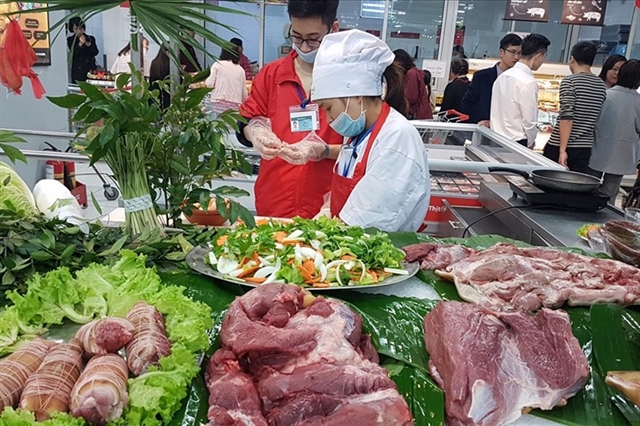 Economy
Economy


|
| Pork supply is expected to be enough form domestic consumption but prices will increase during the Tết (Lunar New Year) holiday. — Photo laodong.com.vn |
HÀ NỘI — Although pork is plentiful right now, the demand is expected to rise at the end of the year, then rocket by as much as 25 per cent when the Tết (Lunar New Year) holiday is coming near.
To meet the increase, Nguyễn Xuân Dương, acting director of the Ministry of Agriculture and Rural Development (MARD)’s Department of Livestock Production, said there must be close cooperation between the agriculture and trade and industry sectors.
He said the average price of pork is still stable, around VNĐ65,000-66,000 per kilo in the north and about VNĐ60,000-61,000 in the south.
But there has been a price increase recently to VNĐ75,000 per kilo but this is due to mistakes in circulation and miscommunication, not lack of supply, according to the Ministry of Agriculture and Rural Development (MARD).
Dương also said the domestic market has not ran out of pork because many localities such as Bắc Giang and Hưng Yên provinces still have large supply of pigs.
Together with dealing with the African swine flu, the domestic agriculture sector has instructed to raise poultry, cattle and seafood so the total food supply does not fall short.
According to the MARD's Department of Animal Health, the African swine fever virus has so far spread to more than 7,700 communes of nearly 650 districts in all 63 provinces and cities of Việt Nam.
More than five million pigs have been culled in a bid to stop the outbreak spreading.
Kiều Đình Thép, sales director of CP Vietnam Livestock Joint Stock Company, said pork supply has increased by about 10 per cent against last year with an average selling price at VNĐ65,000 per kilo. The company will keep its pork price stable until the end of the year.
To increase the supply, CP Vietnam has improved productivity and re-breeding herds with biosecurity measure, Thép said.
Nguyễn Văn Long, deputy director of the Department of Animal Health, said pig producers should use biosecurity and control measures to gain success in increasing number of pigs. — VNS




